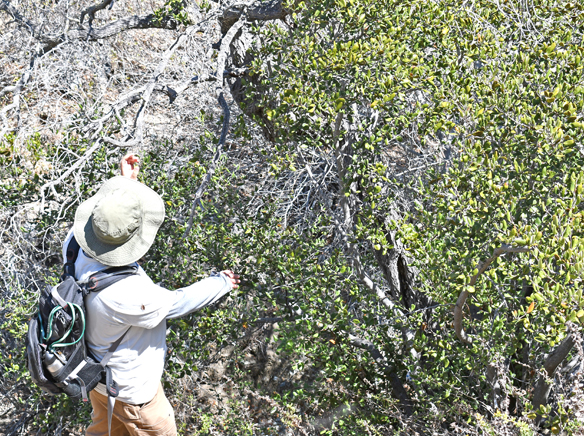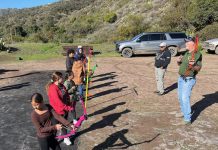
Critically endangered Mountain Mahogany on road to recovery
The dust swirls on a sweltering Catalina Island day. Somehow, the back side of the Island seems even hotter. Though sun bakes the ground, excitement pervades the day’s prospect: searching for the elusive Catalina Island Mountain Mahogany (Cercocarpus traskiae).
This critically endangered, neoendemic species only exists in one known population in Wild Boar Gully on Catalina Island.
“This is a very special place for many reasons, but one of them is that it’s the home of what is probably the rarest tree in the United States, if not in North America: Cercocarpus traskiae,” said Catalina Island Conservancy Botanist and Native Plant Manager Seth Kauppinen.
Around 40 plants were counted when Blanche Trask first discovered the species in the late 19th century.
“As a result of nonnative mammalian herbivores – things like goats, pigs and deer – they were dramatically reduced,” said Kauppinen. In fact, a survey in 1996 identified only around six mature plants. “Now, it looks like the plants are recovering because back in the ’90s the Conservancy fully enclosed this gully in robust fencing to keep those mammals out.”
After around an hour carefully trudging through the canyon, almost turning around more than once, the Catalina Island mountain-mahogany appeared. The grove showed signs of growth, with several saplings sprouting forth. The largest example spotted reached more than 12 feet tall, with mature trees able to grow to around 26 feet in height.
“The biggest difference between this and the more typical Cercocarpus betuloides [Mountain mahogany] is that its leaf is leathery in texture, and the abaxial (lower) surface is very fluffy or tomentose – wooly, even,” said Kauppinen. “That’s unique in this genus, so it’s pretty easy to identify.”
This neoendemic species is a conservation-reliant species, depending on care including fencing in order to survive. The fences erected in the 90s have had a salutary effect. “Most of the trees we’ve seen have sprouts at their base where they’re regrowing, and there are a number of seedlings,” said Kauppinen.
There are two main types of endemic species: neoendemic and paleoendemic, referring to how a species came to be found in just one place. In the case of a neoendemic, such as the Catalina Island mountain-mahogany, the species evolved in its present location and never spread. Paleoendemic species, such as the Channel Islands Ironwood (Lyonothamnus floribundus), are relicts of a once widespread group, their range now reduced to a pale echo of a glorious past. The Ironwoods left fossils all over western North America, but today cling to life on just a few islands. Spending some time among this ancient grove is humbling.
“Being in the presence of these trees feels pretty sacred because there are only a few left and they’ve been sitting here minding their own business for millennia,” said Kauppinen. “This is one of the things that makes Catalina a very special place.”










